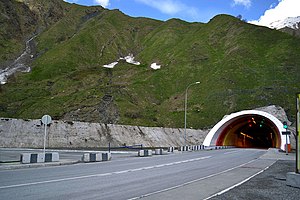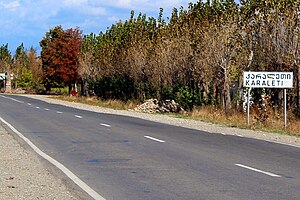S-10 (Georgia)
| საერთაშორისო 10 (Georgian) | ||||
| Gori-Tskhinvali-Gupta-Java-Roki | ||||
| Route information | ||||
| Length | 92.5 km[1] (57.5 mi) | |||
| Existed | 1996–present | |||
| Major junctions | ||||
| South end | Gori | |||
| ||||
| North end | Russian border (Roki) | |||
| Location | ||||
| Georgia | ||||
| Municipalities | Gori, Java | |||
| Major cities | Gori, Tskhinvali | |||
| Highway system | ||||
| ||||
| ||||
The S-10 route (Georgian: საერთაშორისო მნიშვნელობის გზა ს-10, Saertashoriso mnishvnelobis gza S-10, road of international importance S-10), also known as "Gori-Tskhinvali-Gupta-Java-Roki (Russian border)", is a 92.5 kilometers (57.5 mi) long "road of international importance" within the Georgian road network.[1] Roughly two-third of the highway is located in the Russian-occupied South Ossetia region and passage is blocked just South from the South Ossetian administrative capital Tskhinvali.
The highway begins in the centre of Gori and leads via Tskhinvali to the Russian border at the Roki Tunnel, where the road reaches its highest point of 2,112 m (6,929 ft) above sea level. The road is often referred to as Transkam or Transcaucasian Highway. It is not part of European or Asian international highway routes.
History
The current route S-10 was divided over different routes within the Soviet road network classification introduced in 1982. The Gori-Tskhinvali-Java segment was part of the R-2 route that continued via Kvaisa until Oni, while the Java-Roki segment of today's S-10 was designated R-24 when the Roki Tunnel opened in 1984. On the Russian SFSR side of the Roki Tunnel the Transkam Highway, which was finished in 1986, continued as R-297 to Alagir. Prior to the 1980s the route of today's S-10 was unnumbered as was the case with most Soviet roads.[2]
In 1996 the current Georgian classification system was adopted and the "roads of international importance" was introduced as its highest class with the letter S and the "S-10 Gori-Tskhinvali-Gupta-Java-Roki (Russian border)" replaced the old designations.[3]
Roki Tunnel
Before the tunnel through the Roki Pass opened in November 1984, there was no direct road from the South Ossetian Autonomous Oblast of the Georgian Soviet Republic to the North Ossetian Autonomous SSR of the Russian SFSR. At most there was a dirt track after an abandoned attempt in the 19th century to build a road.[4] Instead, the Ossetian Military Road via the Mamison Pass was constructed in the 19th century which was the shortest option until 1984 to reach South Ossetia by road from the north, besides the Georgian Military Road via Kazbegi. Despite its name, the Ossetian Military Road did not provide a direct connection to South Ossetia, but skirted its northwestern borderlands.
The lack of direct connections between the Ossetian communities on either side of the mountains triggered the Ossetian autonomous authorities to campaign with the respective Soviet authorities for a railroad and later a road through the mountains. After a last attempt in the late 1940s for a railroad connection through the Dzomag (Magsky) Pass, 3 km (1.9 mi) west of Roki, and various geological and design studies into a road connection, the Council of Ministers of the Soviet Union decreed in 1971 a road connection through Roki. Upgrading the existing Mamison route with a tunnel was part of earlier surveys, but despite being geologically more advantageous this was dismissed in favor of the Roki variant which required a shorter tunnel.
Georgian Soviet authorities had long attempted to prevent a direct rail or road connection between the South Ossetian oblast and the North Ossetian republic, fearing nationalist unity, but eventually had to succumb to Moscow. The scope was to build a road that would be open year-round. Both the Ossetian and Georgian Military Roads were sensitive to snowdrift leading to seasonal closures. The Roki tunnel opened in 1984 and was the longest within the Soviet Union upon its commissioning with a length of 3,730 m (2.32 mi). The Transkam Highway was completely finished in 1986.[5]
Route description
The S-10 highway begins in the city of Gori at an elevation of 600 m (2,000 ft) above sea level and goes to the Russian border in the Caucasus Mountains at an elevation of more than 2,100 m (6,900 ft). The landscape is flat with a slight incline towards the north until the de facto South Ossetian border, reaching an elevation of 850 m (2,790 ft) at the conflict line near Tskhinvali. Beyond Tskhinvali the route enters the Greater Caucasus mountain range and follows the Liakhvi river and its upper tributaries to the highest regions of the road. The route enters Russia via the Roki Tunnel.
Gori - Ergneti
Starting in the centre of Gori the S-10 runs from the Gori Fortress northbound out of town towards the S1. This highway provides a motorway connection to Tbilisi and the western parts of Georgia. Passing underneath the motorway the S-10 runs in a straight line through the flat agricultural land towards Karaleti village, parallel to the Liakhvi river at a distance of a few kilometers. Even though the road is closed for through traffic into Tskhinvali and South Ossetia, it has importance for the area just south of it with many Georgian communities dotted near the occupation line. Just north from the village of Ergneti a roadblock at the occupation line prevents further travel, from either side. Since the 2008 Russo-Georgian war the site is used for conflict resolution meetings and the exchange of detainees through the mediation of international actors.
Tskhinvali - Roki
South Ossetia's administrative capital and only city Tskhinvali is located directly north from the occupation line. In South Ossetia the S-10 highway is referred to as "Transkam Highway" and is literally the lifeline of the self-declared republic. The Transkam Highway is the only regular road in and out of the region as South Ossetian authorities keep crossing points to Tbilisi controlled Georgia closed for ordinary traffic. From the roadblock at Ergneti the road continues north along the Liakhvi river and circumvents the centre of Tskhinvali. After crossing the Liakhvi River the road heads north out of town and after 16 kilometers (9.9 mi) it reaches the small settlement Gupta. Here is the junction with the Sh25 road to Kvaisi, a former lead-zinc mining town.
This point is also the confluence of the Liakhvi and Patsa rivers and has one of the few highway highlights. The landmark 1929 Guftinsky bridge across the Patsa River is not in use anymore but is visible from the 1980s steel-concrete bridge which was built for the Transkam Highway. The old arched bridge with a length of 72 meters (236 ft) and a height of 22 meters (72 ft) was unprecedented at the time in Transcaucasia.[6] The bridge was engineered with German assistance and constructed in a record time of 10 months for the original road to Kvaisi and Oni.
The Transkam Highway continues from there alongside the Liakhvi River, passing the town of Java and other small settlements through forested river gorge. The road eventually reaches Lower Roki from where the road climbs to the Roki Tunnel. In winter the upper parts of the highway are frequently closed for short periods due to heavy snow. After crossing the Russian border the road continues as A164 highway to Alagir and the R217 "Caucasus Highway".
Intersections
The entire route is in Shida Kartli region. Most of the route is located in breakaway South Ossetia and is inaccessible from Georgian controlled territory with a roadblock north of Ergneti village
| Municipality | km | mi | Destinations | Route | Notes | ||
|---|---|---|---|---|---|---|---|
| Gori | 4 | 2.5 | Tbilisi Sokhumi | Highway to | |||
| 10 | 6.2 | Crosses Charebula River | |||||
| 14 | 8.7 | Dzevera | |||||
| 23 | 14 | Crosses Little Liakhvi River | |||||
| 24 | 15 | Ditsi | |||||
| 30 | 19 | ||||||
| De facto border South Ossetia | |||||||
| 32 | 20 | Akhalgori | |||||
| 33 | 21 | Crosses Liakhvi River | |||||
| Java | 49 | 30 | Kvaisi | ||||
| Crosses Patsa River (200 m) | |||||||
| 56 | 35 | Crosses Liakhvi River | |||||
| 58 | 36 | Crosses Gudisistskali River | |||||
| 62 | 39 | Crosses Liakhvi River | |||||
| 77 | 48 | Tunnel (130 m) | |||||
| 78 | 48 | Crosses Somikhdoni River | |||||
| 89 | 55 | Tunnel (360 m) | |||||
| 90 | 56 | Roki Tunnel (3730 m) | |||||
| 92 | 57 | ||||||
| 1.000 mi = 1.609 km; 1.000 km = 0.621 mi | |||||||
References
- ^ a b "2014 List of highways of international and domestic importance" (in Georgian). The Legislative Herald of Georgia. 18 June 2014. Retrieved 22 August 2021.
- ^ "Road numbering systems - Russia". Retrieved 22 August 2021.
- ^ "On Approval of Indicators and List for Determination of International, Domestic and Local Roads of Georgia (1996)" (in Georgian). The Legislative Herald of Georgia. 16 December 1996. Retrieved 22 July 2021.
- ^ "Транскавказская магистраль" [Transcaucasus Highway] (in Russian). Caucasian Knot. 28 August 2016. Retrieved 13 September 2021.
- ^ Gusalov, N.A.; Kortiev, L. I. (1987). Транскавказская автомагистраль [Transcaucasus Highway] (in Russian). Ordzhonikidze (Vladikavkaz): Ir (publishing house).
- ^ "The visiting card of South Ossetia of the last century - the Guftinsky Bridge celebrates its 90th anniversary" (in Russian). Newspaper Respublika SO. 5 November 2019. Retrieved 25 August 2021.
External links
Media related to S-10 (Georgia) at Wikimedia Commons






